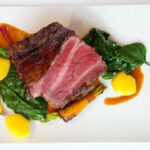There’s something undeniably comforting about a bowl of perfectly cooked rice – each grain tender, distinct, and fluffy, like little clouds on your plate. But achieving that elusive fluffiness can often feel like chasing a culinary myth. Fear not, rice lovers! In this article, we’ll unravel the secrets behind the fluffiest rice ever, guiding you through precise techniques and expert tips that transform ordinary grains into a masterpiece of texture and taste. Get ready to master the perfect cooking method and elevate your rice game to cloud-nine levels!
Fluffiest Rice Ever begins with selecting the right rice variety, understanding the science behind cooking techniques, and mastering precise steps to achieve each grain’s perfect texture. My journey to unlock the secret of pillow-soft rice started when I traveled through Asia, witnessing the meticulous care locals take in rice preparation. The difference lies not just in the grain, but how patience and technique transform it into a delectable masterpiece. Today, I’m excited to share this foolproof method that delivers consistently fluffy rice every time.
Prep and Cook Time
- Preparation: 5 minutes
- Cooking: 18-20 minutes
- Total Time: 25 minutes
Yield
Serves 4 as a perfect side dish or base for your favorite entrée.
Difficulty Level
Easy – ideal for beginner and experienced cooks alike.
Ingredients
- 1 cup long-grain jasmine rice, rinsed thoroughly until water runs clear
- 1 ¼ cups water (preferably filtered or bottled for purity)
- ½ teaspoon fine sea salt
- 1 tablespoon unsalted butter or neutral oil (optional, for silkiness)
Understanding Rice Varieties for Ultimate Fluffiness
The key to the fluffiest rice ever is starting with the right grain. Long-grain jasmine rice is prized for its naturally aromatic, tender but separate grains. Its lower starch content compared to short-grain varieties reduces clumping. If you prefer sturdier texture, basmati is a great alternative. Avoid sticky rice for fluffy results as its high amylopectin starch creates clumps. Proper rinsing removes excess surface starch, crucial to avoiding gummy rice.
The Science Behind Fluffy Rice Cooking Techniques
Rice cooking is all about controlling moisture absorption and heat to allow grains to swell without sticking. Using the correct rice-to-water ratio ensures each grain hydrates evenly. Boiling too rapidly causes breakage and mushiness, while too little water leaves rice undercooked and dry. Simmering on low heat with a tight lid traps steam, gently cooking the rice to perfection. A final resting period allows moisture to redistribute for an airy finish.
Step by Step Guide to Achieving Perfectly Fluffy Rice
- Rinse the rice thoroughly under cold water until the runoff is clear. This step washes away surface starch that causes stickiness.
- Combine the rinsed rice, water, and salt in a medium saucepan. Add butter or oil if desired for enhanced flavor and texture.
- Bring the mixture to a gentle boil over medium-high heat. Stir once to distribute grains.
- Immediately reduce the heat to the lowest setting and cover with a tight-fitting lid. Allow it to simmer undisturbed for 18 minutes. Avoid lifting the lid, which releases steam needed for cooking.
- After cooking, turn off the heat and let the rice rest, covered, for 10 minutes. This step lets residual steam finish cooking and firms the grains.
- Fluff the rice gently with a fork by lifting and turning grains. Avoid stirring vigorously to preserve individual grain integrity.
Expert Tips and Common Mistakes to Avoid for Fluffy Rice Mastery
- Don’t skip rinsing: Residual starch causes clumping and gooey texture.
- Use a heavy-bottomed pot: This prevents hotspots and uneven cooking.
- Match water ratio carefully: Slightly more water results in stickier rice, less risks burning and dryness.
- Keep the lid sealed tightly: Avoid peeking during cooking; trapped steam is the magic behind fluffiness.
- Post-cook resting: This crucial step allows moisture to redistribute creating airy rice.
- Fluff delicately: Use a fork, not a spoon, to keep grains separate and light.
Serving Suggestions
Serve your fluffiest rice ever as the canvas for vibrant curries, grilled meats, or sautéed vegetables. Garnish with freshly chopped scallions, toasted sesame seeds, or a squeeze of lime to elevate the presentation. Pair with a drizzle of coconut milk or soy sauce for additional layers of flavor and mouthfeel. For a festive touch, sprinkle fragrant herbs like cilantro or mint just before serving.

| Nutrient | Per Serving (1 cup cooked) |
|---|---|
| Calories | 205 kcal |
| Protein | 4.3 g |
| Carbohydrates | 45 g |
| Fat | 0.4 g (with butter) |
For more on rice varieties and cooking methods, explore our comprehensive rice guide. To understand rice science at its core, visit ScienceDaily’s report on starch behavior in rice.
Q&A
Q&A: Fluffiest Rice Ever – Master the Perfect Cooking Method
Q1: What makes rice fluffy instead of sticky or mushy?
A1: Fluffiness in rice comes down to properly cooked, separated grains. This means the starches have gelatinized just right, moisture is perfectly absorbed, and the grains haven’t clumped together. Techniques like rinsing, controlling water quantity, and gentle steaming help achieve that airy texture.
Q2: Why should I rinse my rice before cooking?
A2: Rinsing rice removes excess surface starch and any debris, preventing grains from sticking together. Think of it like giving your rice a quick spa treatment before the big show-clean, refreshed, and ready to fluff up beautifully.
Q3: How much water should I use for fluffy rice?
A3: The classic ratio varies by rice type, but a good starting point is 1 cup of rice to 1.5 to 1.75 cups of water for most long-grain varieties. Too much water turns rice mushy; too little leaves it undercooked. Precision is key to that perfectly tender, fluffy bite.
Q4: Is soaking rice necessary for fluffiness?
A4: Soaking isn’t mandatory but can help hydrate rice grains beforehand, especially for varieties like basmati or jasmine. It shortens cooking time and improves texture by allowing the grains to absorb water evenly, leading to lighter fluffiness.
Q5: What cooking methods deliver the fluffiest rice?
A5: The absorption method-simmering rice with just enough water and then letting it steam off-heat-is a favorite for fluffiness. Using a heavy-bottomed pot and tight lid traps steam, ensuring even cooking. Some swear by the oven-baking method for consistent results too.
Q6: How do I fluff rice after cooking?
A6: Once cooking is done, let the rice rest covered for 10 minutes. Then, gently fluff with a fork or chopsticks to separate the grains without crushing them. Avoid stirring vigorously, which can break grains and cause stickiness.
Q7: Can I achieve fluffy rice with a rice cooker?
A7: Absolutely! Rice cookers are designed to control heat and timing meticulously, often producing fluffy rice with minimal effort. Just remember to rinse your rice and use the correct water ratio. Many models have ‘fluffy’ or ‘white rice’ settings for perfect results.
Q8: Does the type of rice affect fluffiness?
A8: Yes! Long-grain rice varieties like basmati and jasmine tend to cook up fluffier due to their lower starch content and distinct grain structure. Short-grain rice is naturally stickier and less fluffy, ideal for sushi or risotto rather than airy side dishes.
Q9: Any secret tips for next-level fluffy rice?
A9: For extra fluffy rice, try adding a small amount of fat, like a teaspoon of oil or butter, to the cooking water. It helps coat grains to keep them separate. Also, avoid lifting the lid during cooking-every peek lets out precious steam, affecting texture.
Q10: How can I fix rice that turns out mushy or clumpy?
A10: Don’t despair! Spread warm rice on a baking sheet and let it air out a bit to dry excess moisture, then fluff gently. Next time, reduce water slightly and rinse the rice thoroughly. Practice will turn you into a fluff master in no time!
In Summary
Mastering the art of perfectly fluffy rice transforms a simple staple into a culinary delight that elevates every meal. With the right technique, patience, and a few insider tips, you can consistently achieve those light, tender grains that invite you back for more. So next time you cook rice, remember: it’s not just about boiling water and waiting-it’s about crafting a texture that brings comfort and joy to your table. Embrace the process, experiment with these methods, and soon you’ll be serving the fluffiest rice ever, every time. Your taste buds-and your dinner guests-will thank you.


